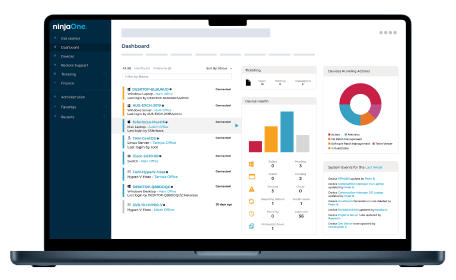Threats & Patches
System Health Policy
Vulnerability Management
Patch Management
Patch Settings
Patch Deployment
Asset Management
Inventory
Application Management and Control
Prohibited Software
- NinjaOne
- Last updated
What are applicable patches?
Applicable patches refer to software updates or fixes that are relevant and necessary for a particular system or application. These patches are designed to address security vulnerabilities, performance issues, or bugs within the software.
Applying patches is crucial for maintaining the security and stability of systems and applications, as they help to close potential avenues for cyberattacks and prevent system malfunctions. Patch management involves identifying which patches are applicable to a particular system or environment, testing them to ensure compatibility and stability, and then deploying them in a timely manner.
Failure to apply applicable patches can leave systems vulnerable to exploitation by malicious actors or result in performance degradation or system failures. Therefore, it is essential for organizations to have robust patch management practices in place to keep their systems up to date and secure.
There are two main contexts where you might encounter “applicable patches”:
- Patch Management Tools: Many patch management programs have a section that displays applicable patches. This section lists the updates recommended for your specific environment, helping you prioritize which ones to install.
- Patch Reports: Patch reports generated by IT systems may also highlight applicable patches. These reports identify missing updates that could leave your systems vulnerable.
How can you identify the applicable patches on a system?
Normally, to identify the applicable patches, a scan process needs to be performed on the system, and this takes time. After the scan has completed, the list of applicable patches along with the patch details is generated. If there’s more than one system, this process needs to be repeated on each of the systems.
As the number of systems increases, this process gets more complicated and time consuming, this is why an automated patch deployment system, like NinjaOne is preferred, which instructs the systems to perform the process in the background without human intervention.
How can NinjaOne help to identify applicable patches on a system?
The applicable patches for a system can be listed after a scan process, NinjaOne can scan for patches either manually by running a scan automation or automatically using a policy.
Manual scan: NinjaOne has a specific scan automation option that is quite easy to use, follow the next instructions to run it.
- Go to Your organization dashboard.
- Find the target computer you want to run the scan automation; you can use filters to help on that.
- Hover the mouse over the target computer until you see a blue arrow that appears at the right of the computer name, then put the mouse pointer on the blue arrow, at this point a drop-down menu will appear. Select OS Update, and then Scan.
- Alternatively, you can click on the target computer name, and a new window showing device details will open. The blue arrow appears at the right of the device name. Hover the mouse over the blue arrow, then Select OS Update, and then Scan.
Automatic scan: If you have a policy for automated patching, the scan process happens in the background at the configured schedule, then the patch installation and reboot will happen at the scheduled time defined in the policy.
Next Steps
Applicable Patches FAQs
What are applicable patches?
Applicable patches refer to software updates or fixes that are relevant and necessary for specific applications or systems within your network. These patches address vulnerabilities, security issues, or functional improvements.
What are the examples of software patches?
Here are some examples of software patches.
1. Security Patches:
These address vulnerabilities in software and enhance system security.
- Operating System Patches: Regular updates provided by operating system vendors (e.g., macOS, Windows) to fix security flaws and improve stability.
- Application Patches: Updates for software applications, like Chrome, Firefox, Office, etc., to protect against known vulnerabilities.
- Firmware Patches: Updates for devices like laptops, handheld devices, and routers to address security issues.
2. Bug Fix Patches:
These resolve errors or issues in software code.
For instance, if a program crashes unexpectedly or displays incorrect results, a bug fix patch corrects these issues.
3. Feature Update Patches:
These introduce new features or improvements to existing software.
Feature updates enhance functionality, user experience, or performance.
Ready to become an IT Ninja?
